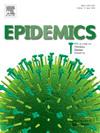Investigating the impact of edge weight selection on the pig trade network topology
IF 2.4
3区 医学
Q2 INFECTIOUS DISEASES
引用次数: 0
Abstract
Traceability of animal movements and robust surveillance are crucial for prevention and control of animal diseases. While network analysis has emerged as a powerful tool for identifying higher-risk holdings through centrality metrics, its effectiveness depends on two methodological choices: (1) edge-weighting schemes (movement frequency vs. animal volume) and (2) centrality metric selection. This study investigates how alternative edge-weighting approaches (frequency vs. volume) influence network topology and node centrality rankings in a pig movement network.
Using 2021 pig movement data from Upper Austria (5,766 holdings; 92,914 movements), we: (1) quantify how edge-weighting schemes (frequency vs. volume) affect network topology and community structure, and (2) evaluate node ranking robustness across three centrality metrics (strength, betweenness, closeness) against epidemic simulation rankings. Our analysis reveals distinct edge weight distributions: frequency-based network exhibited a bimodal pattern, while volume-based was more uniform. We observed strong positive correlations ( 0.42–0.84; ) in node rankings across all centrality metrics (strength, closeness, betweenness), with consistent patterns observed both: (i) between frequency- and volume-weighted networks, and (ii) within each network representation. Strength centrality exhibited the highest correlation with the simulation-based rankings, particularly for the top 5% highest-ranked nodes ( 0.51 for frequency-based and 0.5 for volume-based). These findings highlight that strength centrality provides a computationally efficient and field-practical alternative to epidemic simulations for identifying high-risk holdings. This enables resource-efficient, data-driven surveillance while maintaining epidemiological relevance.
研究边权选择对生猪交易网络拓扑结构的影响
动物运动的可追溯性和强有力的监测对于预防和控制动物疾病至关重要。虽然网络分析已经成为通过中心性指标识别高风险持股的有力工具,但其有效性取决于两种方法选择:(1)边缘加权方案(运动频率与动物体积)和(2)中心性指标选择。本研究探讨了不同的边加权方法(频率vs.体积)如何影响猪运动网络中的网络拓扑和节点中心性排名。利用来自上奥地利州(5,766个存栏;92,914次移动)的2021年生猪移动数据,我们:(1)量化边缘加权方案(频率与体积)如何影响网络拓扑和社区结构,(2)评估三个中心性指标(强度、中间度、接近度)对流行病模拟排名的节点排名稳健性。我们的分析揭示了明显的边缘权重分布:基于频率的网络呈现双峰模式,而基于体积的网络更为均匀。我们观察到,在所有中心性指标(强度、亲密度、中间度)的节点排名中,存在很强的正相关性(τ > 0.42-0.84; p<0.001),并且在以下两方面观察到一致的模式:(i)频率加权和体积加权网络之间,以及(ii)每个网络表示内部。强度中心性与基于模拟的排名表现出最高的相关性,特别是对于排名前5%的节点(基于频率的τb = 0.51,基于体积的τb = 0.5)。这些发现突出表明,强度中心性为确定高风险资产提供了一种计算效率高、现场实用的流行病模拟替代方法。这可以实现资源高效、数据驱动的监测,同时保持流行病学相关性。
本文章由计算机程序翻译,如有差异,请以英文原文为准。
求助全文
约1分钟内获得全文
求助全文
来源期刊

Epidemics
INFECTIOUS DISEASES-
CiteScore
6.00
自引率
7.90%
发文量
92
审稿时长
140 days
期刊介绍:
Epidemics publishes papers on infectious disease dynamics in the broadest sense. Its scope covers both within-host dynamics of infectious agents and dynamics at the population level, particularly the interaction between the two. Areas of emphasis include: spread, transmission, persistence, implications and population dynamics of infectious diseases; population and public health as well as policy aspects of control and prevention; dynamics at the individual level; interaction with the environment, ecology and evolution of infectious diseases, as well as population genetics of infectious agents.
 求助内容:
求助内容: 应助结果提醒方式:
应助结果提醒方式:


